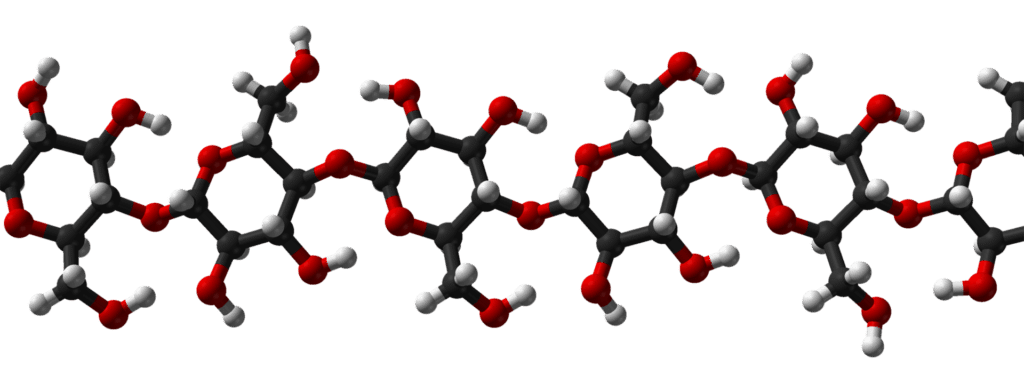DNA shares several similarities with RNA, it also has distinct characteristics which differentiates it form RNA. Some major differences between DNA and RNA can be outlined as follows:
Deoxyribonucleic Acid (DNA)
- DNA is a long, linear polymer composed of four types of deoxyribonucleotides: adenine (A), cytosine (C), guanine (G), and thymine (T). These nucleotides are linked together by covalent phosphodiester bonds, which connect the 5′ carbon of one deoxyribose sugar to the 3′ carbon of the next.
- DNA is composed of a pentose sugar, phosphoric acid, and nitrogen-containing cyclic bases. The sugar present in DNA is β-D-2-deoxyribose. The nitrogenous bases in DNA include adenine (A), guanine (G), cytosine (C), and thymine (T).
- The specific arrangement of these bases within the DNA structure plays a key role in passing genetic information from one generation to another. DNA exists as a double-stranded helix, with the two strands being complementary to each other.

Ribonucleic Acid (RNA)
- RNA is a long, unbranched macromolecule (structure) made up of nucleotides connected by 3′ → 5′ phosphodiester bonds, present in viruses, prokaryotic cells, and eukaryotic cells, mainly found in the cytoplasm and serves for gene coding, decoding, regulation, and expression.
- RNA consists of phosphoric acid, a pentose sugar, and nitrogen-containing cyclic bases. In RNA, the sugar is β-D-ribose. The nitrogenous bases found in RNA are adenine (A), guanine (G), cytosine (C), and uracil (U), with uracil taking the place of thymine, which is present in DNA.
- RNA generally exists as a single strand but can fold upon itself, creating regions with a double helix structure.

Differences Between DNA and RNA
- RNA differs from DNA by the presence of a hydroxyl group at the 2′ position of the ribose sugar. This functional group allows RNA to adopt the A-form geometry, in contrast to the B-form typically seen in DNA.
- In RNA, the sugar to which the phosphates and nitrogenous bases are attached is ribose, unlike the deoxyribose found in DNA.
- RNA does not contain thymine, except in rare cases such as in transfer RNA.
- RNA typically exists as a single strand, whereas DNA usually forms a double-stranded helical structure. However, RNA can fold back on itself, forming hairpin-like structures and acquiring double-stranded characteristics.
- Since RNA is usually single-stranded, the amount of guanine does not necessarily equal the amount of cytosine, and similarly, the adenine content does not necessarily match that of uracil.

Major differences between DNA and RNA – Deoxyribonucleic Acid vs Ribonucleic Acid
| Deoxyribonucleic Acid (DNA) | Ribonucleic Acid (RNA) |
| Primarily found in the chromatin of the cell nucleus. | The majority of RNA (90%) is found in the cell cytoplasm, with a small amount (10%) located in the nucleolus |
| Never found in the cytoplasm in a free state. | RNA can exist in a free state. |
| Usually double-stranded, but occasionally single-stranded. | Typically, RNA is single-stranded, but can occasionally be double-stranded. |
| DNA consists of both “sense” and “antisense” strands | The RNA sequence is identical to that of the “antisense” strand. |
| The sugar in DNA is 2′-deoxyribose, which has an H atom at the C-2 position. | The sugar in RNA is ribose, which contains a 2′-hydroxyl group. |
| The sugars in DNA adopt a C2′-endo form. | The sugars in RNA are in the C3′-endo form. |
| The common nitrogenous bases are adenine, guanine, cytosine, and thymine (uracil is absent). | The common nitrogenous bases in RNA are adenine, guanine, cytosine, and uracil (not thymine). |
| Base pairing occurs with adenine pairing with thymine and guanine with cytosine. | When base pairing occurs, adenine pairs with uracil, and guanine pairs with cytosine. |
| The ratios of adenine to thymine (A/T) and guanine to cytosine (G/C) are approximately one. | RNA does not require complementary base ratios. |
| Base pairing happens along the entire length of the DNA molecule. | Base pairing occurs only in the helical regions of the RNA molecule, which make up about 50% of the total molecule. |
| DNA contains only a few unusual bases. | RNA contains more unusual bases compared to DNA. |
| DNA comes in three forms: filamentous (double helical), circular, or single-stranded. | There are five types of RNA: viral RNA, rRNA, tRNA, mRNA, and double-stranded RNA. |
| It consists of a large number of nucleotides (up to 3-4 million), giving it a high molecular weight. | RNA consists of fewer nucleotides (up to 12,000), giving it a lower molecular weight. |
| DNA stains blue with azureph thalate. | RNA stains red with azureph thalate. |
| DNA serves as a template for its own synthesis. | RNA does not serve as a template for its own synthesis. |
| During replication, DNA forms more DNA, and during transcription, it forms RNA. | RNA typically does not replicate or undergo transcription. |
| DNA can partially reanneal under slow cooling conditions. | RNA melting is completely reversible and occurs almost instantly. |
| DNA can undergo mutations. | RNA does not undergo mutations. |
| DNA is the typical genetic material. | RNA acts as the genetic material only in certain viruses. |


